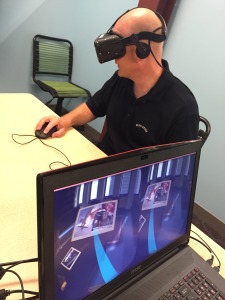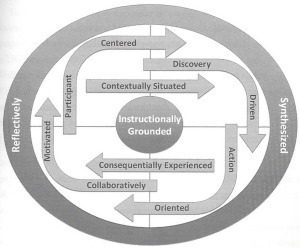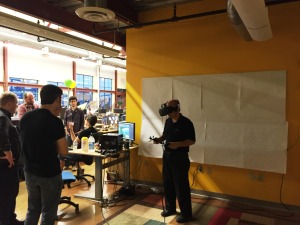Principles for Creating a Successful Virtual Reality Learning Experience
In a recent article 3 Instructional Design Strategies For Virtual Reality Learning, I discussed three (among many) instructional design strategies for VR: Conceptual Orienteering, Critical Incident and Operational Application. In this article, I step back and look at seven fundamental principles that need to be designed into any VR experience. You’ll notice that all of these principles are included in the three instructional strategies mentioned in the above article.
To dig into the subject more deeply, check out the book Tony O’Driscoll and I wrote (with a bunch of help from some really smart people) called Learning in 3D. The book provides a model called 3DLE which builds from 3D sensibilities in VR (like sense of self and sense of space) to design principles (discussed here) with several instructional strategies and overall macrostructures sandwiched in the middle. It’s a great start for anyone thinking of developing VR learning experiences.
Introduction
An ideal Virtual Reality (VR) learning experience should be designed to create engaging interactions that help the learner assimilate new information, ideas and concepts resulting in the acquisition of new skills transferable skills. Good examples and overall design strategies are outlined in a new, free online publication by the Masie Group called VR Learn: Virtual Reality and Learning.
The report is a great place to learn what is being done, how VR is influencing learning and development and some great examples explaining what types of learning are best suited to VR experiences. To add to the growing body of ideas around VR, this article provide what Tony O’Driscoll and I call Fundamental Principles.
These are principles that are required for VR learning experiences and are fundamental to creating effective learning with VR technologies. We originally outlined the principles in our book Learning in 3D.
Instructionally Grounded
This principle is required for any instructional intervention. It is essential that the learning being designed address a vetted business need and that a learning solution is the best and most cost effective way to address the deficiency. With VR, especially, designers and stakeholders need to avoid the attraction of the technology just for technology’s sake. Vet the learning need and make sure VR is the best approach for addressing the need.
Participant Centered
The participant should be positioned at the center of the learning experience. In a VR learning experience the locus of control moves from the instructor to the learners and the contextual design must accommodate the actions and interactions of the participant. When considering the design of a VR learning experience, the designer needs to think about the learner standing in the middle of the learning. Everything that happens must revolve around the learner. When designing a VR learning experience, learners need to become a component in the design of the experience itself. Designers must create a learning experience where content and process are fused to the point where the distinction between learning and doing becomes almost imperceptible.
Contextually Situated
The design of a VR learning experience must move beyond replicating a classroom into the realm of situated context. The context of the VR environment must be authentic and action oriented, but it must also be bounded in such a way that it ensures all of the learning objectives are encountered by the participant without it being too obvious or onerous. Striking the right balance between contextual authenticity and learning objective coverage is essential in setting the appropriate context within which to situate the learning experience.
Action Oriented
VR learning experiences need to be about action. As learning expert and virtual world expert Randy Hinrichs astutely pointed out in Learning in 3D “It’s not about being there, it’s about doing there.” Create the VR environment so that the learning objectives are embedded in an experiential activity. If the learner is merely observing in a VR environment, the design has a dramatic shortfall. Think about adding action and activity to the VR experience. Make the learner do something, make movement required and meaningful.
Consequentially Experienced
This principle means there needs to be direct, relevant and realistic consequences for both incorrect and correct actions taken within the VR learning experience. Within the experience, learners should be required to demonstrate their ability to perform a given task or challenge and the experience the consequence of their actions in carry out that tasks and are provided feedback related to the tasks to allow them to improve their performance on subsequent iterations.
Collaboratively Motivated
VR environments allow for connectivity and interactivity among learners. This technological affordance needs to translate into a design affordance. The VR learning environment should not be so structured that learners miss out on the opportunity to participate in peer0to0peer learning and to collectively contribute to a sense-making activity. Participants should simultaneously be consume and contribute to the learning experience. This opportunity to collaborate and co-create in VR learning environments should not be overlooked.
Reflectively Synthesized
There is little meaningful learning without reflection. A learning event without reflection is merely an experience. The design of the VR learning event must include time for some type of reflection whether it is instructor-led, peer-to-peer or an exercise with the learner is forced to reflect at her own pace with an automated debriefing. There needs to be some type of reflection.
Conclusion
These seven principles are foundational to the creation of meaningful and effective learning within a virtual reality environment. If you design your instruction with these seven principles in mind, you’ll have success in achieving the business goals of using VR for learning. If you ignore these principles, your VR learning design might just be more about the VR and less about the learning.
Resource:
If you want to learn more, check out:
About the Author
Karl Kapp: Professor Bloomsburg University, Founder of The Wisdom Learning Group, LLC. A researcher, analyst, speaker, professor, consultant and designer of instructional games and gamification, Karl Kapp is author of six books on the convergence of learning and technology included the best selling gamification book “The Gamification of Learning and Instruction.” He is the creator of the Lynda.com course “The Gamification of Learning” and a TEDx Speaker.
Want to learn more about gamification and learning? You can see Karl at the 2017 Lectora User Conference as a featured speaker. He will also be at the ATD Techknowledge 2017 conference in Las Vegas. And, conducting a “Play to Learn” Workshop at the eLearning Guild’s Learning Solutions Conference. If you are attending those events, stop by and say “Hi”.
Follow Karl’s blog https://karlkapp.com/kapp-notes/.
Need insights, input, ideas, a gamification strategy or an energetic keynote speaker? Karl provides evidence-based guidance, design and advice for creating engaging, meaningful learning (as well as some awesome gamified workshops and learning events.)
Visit www.karlkapp.com for more information on gamification and learning.



